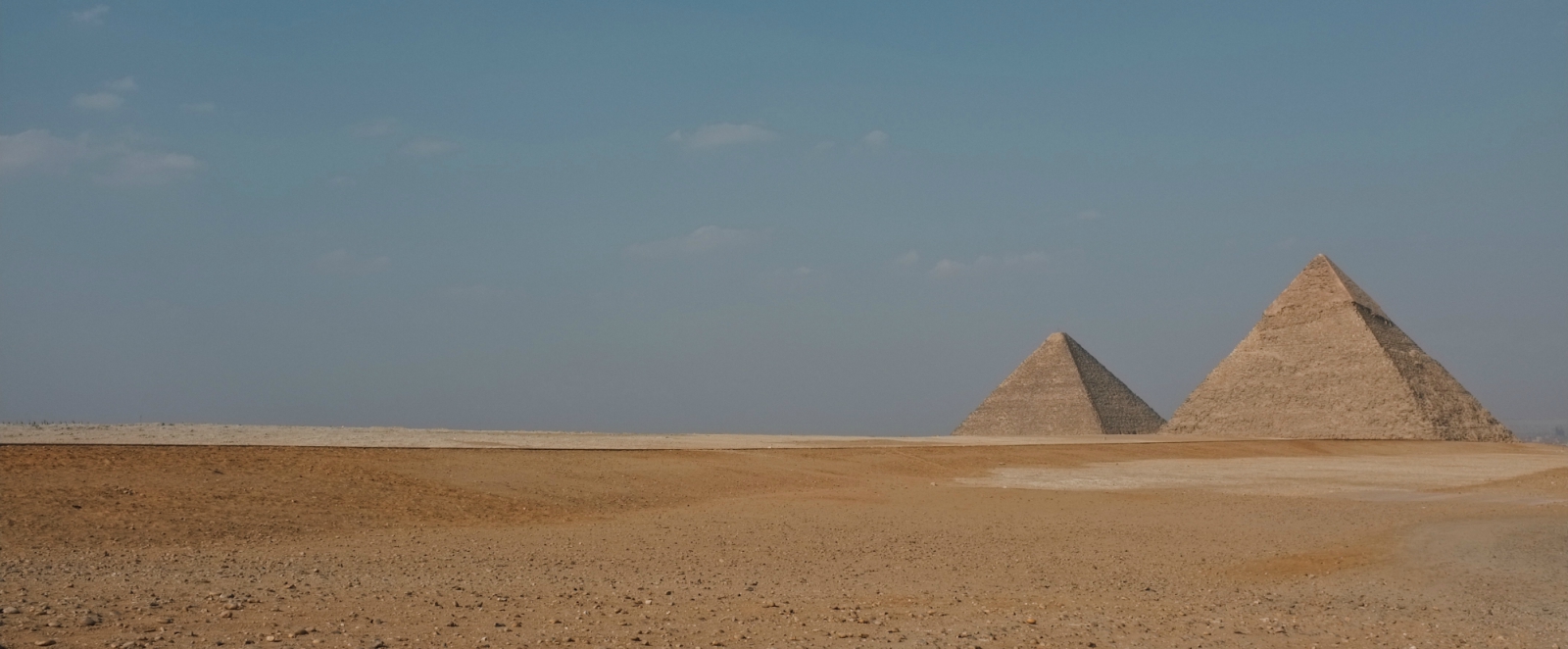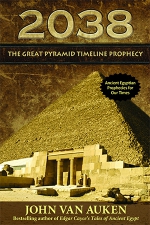The Great Pyramid in Egypt is the only surviving member of the “Seven Wonders of the Ancient World.” The other six wonders were the Colossus of Rhodes, the Statue of Zeus at Olympia, the Mausoleum at Halicarnassus, the Hanging Gardens of Babylon, the Temple of Artemis (Diana) at Ephesus, and the Lighthouse at Alexandria.
Even in the modern world of today, the Great Pyramid on the Giza Plateau is a marvel of design and engineering. Sir Flinders Petrie (1853-1942), an English archaeologist known as the “father of modern Egyptology” wrote: “The pavement, lower casing and entrance passage are exquisitely wrought; in fact, the means employed for placing and cementing the blocks of soft limestone, weighing a dozen or twenty tons each, with such hair-like joints, are almost inconceivable at present; and the accuracy of the leveling is marvelous. How in the casing of the Great Pyramid, they could fill with cement a vertical joint about 5 feet by 7 feet in area, and only an average one-fiftieth (1/50) part of an inch thick is a mystery. Yet this was the usual work over 13 acres of surface, with tens of thousands of casing stones, none less than a ton in weight.” (30, p. 213) W. Marsham Adams (1838-death date unknown), a British Egyptologist, fellow of Oxford’s New College, wrote: “It is absolutely unique. No other building, it may be safely averred, contains any structure bearing the least resemblance to the upper chambers.”(1, p. 34) Architect James Fergusson (1808-1886), the 1871 recipient of the gold medal of the Royal Institute of British Architects, wrote in his book The History of Architecture (published in 1855) that the Great Pyramid is “the most perfect and gigantic specimen of masonry that the world has yet seen. No one can possibly examine the interior of the Great Pyramid without being struck with astonishment at the wonderful mechanical skill displayed in its construction. The immense blocks of granite brought from Syene [Aswan, in southern Egypt], a distance of 500 miles, polished like glass, are so fitted that the joints can scarcely be detected. Nothing can be more wonderful than the extraordinary amount of knowledge displayed in the construction of the discharging chambers over the roof of the principal apartment, in the alignment of the sloping galleries, in the provision of the ventilating shafts, and in all the wonderful contrivances of the structure. Nothing more perfect, mechanically, has ever been erected since that time.” (18, p. 85)
Features of the Great Pyramid
There is no way to give all of the amazing features, mathematical wonders, and marvelous engineering feats of this pyramid without becoming overwhelmed. And there are plenty of books and Web sites that do this for you. But some of the more mysterious features should be noted here for they lend greater credence to the pyramid prophecy. First among the mind-stretching facts about this wonder is the extraordinary degree of precision found throughout it. The architects and builders were more than the theory of evolution would tolerate, given that everything old is primitive and we today are the apex of evolution. How could ancient primitives conceive of such a structure and then execute the building of it within tolerances that would be very difficult, if not impossible, to recreate today? We have already read the comments and the astonishment of some the experts who studied the edifice in the 1800s. Here are some of the most perplexing and mysterious features:
- The Great Pyramid is positioned so exactly due north that it is more accurate than the modern attempt at the Paris Observatory, which is within 6 minutes of a degree of exact north. The ancient Great Pyramid is within 3 minutes of exact north and this after roughly four thousand years of settling (subsidence) and earthquakes! This is an astonishing achievement by ancient builders. It also appears to be positioned in alignment with specific stars above it! In an early announcement of this fact by Robert Bauval and Adrian Gilbert in their popular book The Orion Mystery, it was proposed to be in alignment with the star Alnitak in the Belt of Orion, and the other two Giza Plateau pyramids (Khafre and Menkaure) aligning with the other two stars in the Belt (Alnilam and Mintaka). Even the offset star Mintaka matched the offset Menkaure pyramid. (Note that two of the three pyramids are inline with one another, but the third is slightly off-line. See illustration 1.) But after further investigation, it was found that this alignment was more of a mirror image, not a directly overhead match. Then another researcher, Andrew Collins in his book The Cygnus Mystery, revealed that many of the structures on the Giza Plateau, including the Great Pyramid, aligned precisely with Cygnus, the Swan Constellation. (See illustration 2.) How could these ancient people align their work with stars? And why would they attempt such a difficult feat?
- We have already read a bit about the precision with which the stones were cut and put together, but the cement used to hold these stones in place is unknown to scientifically oriented researchers. Even when our modern labs discovered the elements of the chemical composition of the cement, they were unable to duplicate it! How is this possible? From where did the ancient ones get this cement? How did they produce it, given their primitive conditions in comparison to ours? But wait, there’s more! In 1986 a French research team found sand in a hidden chamber behind the wall of the passageway to the Queen’s Chamber, and when they examined the sand, it was found not to be indigenous to Giza! From where did the ancient ones get this sand? And why would they hide it in a secret chamber? Are they trying to convey some strange message to us? Aren’t we the high point of evolution and science? These two discoveries add to the mystery and wonder of the Great Pyramid and the intentions of its ancient designers and builders.
- The red granite coffin (or sarcophagus) in the King’s Chamber is too large to fit through the entrance to this chamber! Did these builders actually build this magnificent chamber around the coffin? If so, why? What purpose could justify adding so much difficulty to building the chamber? One might consider that they wanted to prevent the sarcophagus from ever being taken out of that chamber—but what a feat of engineering and manpower to build the massive chamber around the coffin. And what were they doing with this coffin that never contained a mummy and did not require a lid?
- There is growing evidence that the ancient Egyptians could not build this pyramid. It’s true! Attempts have been made to prove that the pyramid could be constructed using known ancient Egyptian tools and methods. Egyptologist Dr. Mark Lehner made an attempt with a large group of people, but when the structure that he and his team built reached twenty feet high (six meters), they had to use a truck with a winch to get even the downsized stone blocks out of the quarry. They only attempted to cut and stack small blocks, so keep in mind that many of the stones in the Great Pyramid weigh from 2.5 to 70 tons and had to be hoisted to heights over four hundred feet! In the late seventies a Japanese team, funded by auto manufacturer Nissan, made another attempt to create a scaled-down model of the pyramid 59 feet high (18 meters) using the same primitive ancient Egyptian tools archaeologists assume were used, such as chisels and hammers. The highly skilled and technically savvy Japanese team could not cut the Aswan granite. They ended up using jackhammers. They were also unable to move the stones and ended up using bulldozers, a truck, and even a helicopter to get the blocks stacked in a pile that remotely resembled a pyramid. Again, like Dr. Lehner and his team, the Japanese used only small blocks, nothing close to the size and weight of those in the Great Pyramid. This situation is perplexing, leading us to no answers as to how this pyramid was built by these people. But even today we may not be able to build a structure like this because we have only two cranes on the planet that could possibly lift some of the stones in the pyramid to the heights necessary to place them on the levels they are found in that structure. Clearly we are dealing with a people and a monument that is more than it appears to be.
Excerpted from 2038: The Great Pyramid Timeline Prophecy.







